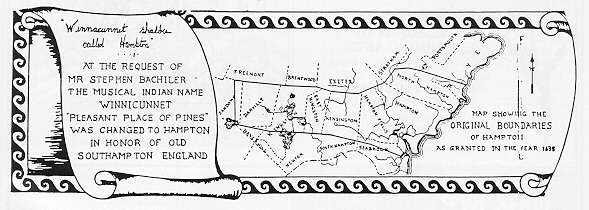Official Souvenir Program Book
January 1 – December 31, 1988
By Gerald A. (Jerry) McConnell
1987 Version
Many current residents and others close to our scene often see the name Winnacunnet being referred to in close relationship to the name Hampton. Why is it that our town was once called Winnacunnet and now it bears the name Hampton?
Joseph Dow, the author of The History of the Town of Hampton from its settlement in 1638 to the autumn of 1892, from whence came the information herein, states that Hampton was once known as Winnacunnet. To Explain, Mr. Dow takes us back to the early sixteen hundreds when this area was called by the Indians, Winicowett; interpreted to mean, “Pleasant Place of Pines” or “Beautiful Place of Pines”, or “Pleasant and Beautiful Place of Pines.”
In the autumn of 1638 the Massachusetts Bay Colony, which at that time held jurisdiction over the territory here, received a petition signed by the Rev. Stephen Bachiler and others asking leave to settle in the area known as Winicowett. The General Court Records show that the petitioner’s request was granted. This small group of people had mostly been living in Newbury, not many miles distant, and had undoubtedly already explored the land for settlement.
During that same year of 1638, A Mr. Jonathan Wheelwright and others had purchased a large tract of land from the Indians and had begun the settlement of Exeter. When Rev. Bachiler’s party began to establish their settlement, Mr. Wheelwright petitioned the Massachusetts General Court to have them cease and desist as they were encroaching on the land purchased from the Indians. The General Court replied that they looked at Wheelwright’s purchase of the land from the Indians as against “Good Neighborhood, religion and common honesty” when his company should have known that at the time of their purchases, Massachusetts had claimed Winicowett as coming within their area of jurisdiction. In fact, Massachusetts had taken possession by erecting a “bound” house two years earlier. Apparently no difficulties occurred and the settlements probably reached some sort of adjustment as there were no unpleasant subsequent transactions or illusions between them.
The settlement began on October 14, 1638, when Rev. Bachiler and his group sailed up the Hampton River in small boats. They landed and went forward through the area looking for the Bound House that had been erected in 1636 by persons authorized by the General Court. Being unable to find the house, the settlers put up the first building a short distance from where they had landed in the place we now call Meeting House Green.
The settlers worked very long and hard to establish their community prior to the arrival of the winter of 1638, and by the spring of 1639, they had established themselves as a town. On the seventh of June of 1639, the Town of Winnacunnet (changed from Winicowett due to phonetic interpretation) was incorporated by the General Court; however, later in 1639, the fall session of the General Court officially renamed the town, Hampton, with a brief record which stated “Winnacunnet shalbee called Hampton.” This was done at the request of Rev. Bachiler. Also at this time, the town was given full possession of town powers and privileges including the right of disposing of and laying out the land.
Why was Winnacunnet renamed Hampton? There exists no known evidence or documentation regarding the change, but it is known that Rev. Bachiler came to this country from South Stoneham in England which was a dependency of St. Mary’s Church in Southampton, which town was commonly called Hampton and referred to as Southampton to distinguish it from the town of Hampton in Middlesex County in England. Thus, Rev. Bachiler’s association with Hampton, England and also the possibility that our Hampton River was of some resemblance to the Southampton water, may have given cause to the changing of the name from Winnacunnet to Hampton.
So yes! Hampton was once known as Winnacunnet, but it appears to have lasted only the relatively short period of one year. Yet it is amazing that today, three hundred and fifty years later, the name Winnacunnet is still very prominent in this town; the two greatest reminders of which are our Winnacunnet High School and Winnacunnet Road which runs east and west from Lafayette Road to the ocean. It can also be found on our town seal and on the cover of this book.
Long live Winicowett – Winnacunnet – Hampton!.
{From the 1938 Tercentenary map designed by Eloise Lane Smith.}
Back to previous section — Forward to next section — Return to Table of Contents
